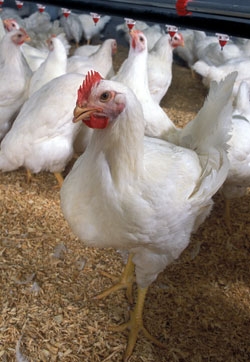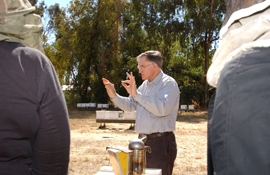Posts Tagged: honeybees
The price of chicken feed is rising
Soaring feed costs are forcing San Joaquin Valley poultry producers to cut costs, raise prices - and, in some cases, close their doors, reported Robert Rodriguez in the Fresno Bee this weekend. Feed prices have climbed as much as 50 percent since last year, fueled by the increasing demand for corn.
Director of the UC Agricultural Issues Center Daniel Sumner told the reporter that rising costs for poultry producers will boost the retail price, unless something else acts to keep prices down.
"So, bottom line," Sumner said, "we should see higher retail prices with these high grain and oilseed prices."
Ranchers beef over obstacles to local meat
Carlos Alcalá, Sacramento Bee
Small ranchers in El Dorado County gathered at a Local Meat Summit in Placerville last week to discuss obstacles to selling their products locally. Meat must be harvested at a USDA-approved facility, and there aren't many of those.
Program representative Sean Kriletich of UC Cooperative Extension in Amador and Calaveras counties is working with ranchers to solve the problem.
"We're trying to work toward getting a USDA-inspected facility for our region," Kriletich said.
If more small ranchers can find a way to sell grass-fed beef locally, it will do more than benefit the farmers, Kriletich said. It will preserve open space for the entire community.
"If people want to keep more land in agriculture, we have to get more money to the producers," said Kriletich, who said he used to run cattle himself, where El Dorado Hills subdivisions now sit.
Beekeepers asking Humboldt cities to loosen regulations on residential hives
Grant Scott-Goforth, The Willits News
A recent change in attitudes toward urban sustainability and education about bee culture spurred the Humboldt County Beekeepers Association to ask the cities of Arcata and Eureka to loosen restrictions on residential beekeeping.
UC Cooperative Extension farm advisor Deborah Giraud said the risks of keeping bees in residential areas are minimal. ”In general, it's really important to have more honeybees,” Giraud said. “We have a lot of problems with pollination here because of weather. Most calls in here are about fruit trees. And it's a pollination problem.”
No explanation yet for mysterious bee deaths
Even though scientists have been studying colony collapse disorder of honeybees for five years, the relentless bee mortality still has them mystified, according to a segment that aired on PBS' NewsHour yesterday.
"We really don't seem to have accomplished a whole lot, because we're still losing, on an average, approximately 30 percent or more of our colonies each year. And that's higher than it used to be," UC Cooperative Extension bee expert Eric Mussen told reporter Spencer Michels. "Only 25 percent of the beekeepers seem to have this CCD problem over and over and over. The other 75 percent have their fingers crossed and say, I don't know what this is, but it's not happening to me."
Michels outlined some of the research into the possible causes of persistent bee decline. At UC Davis, scientists are trying to find ways to improve bee health by changing what they eat and selectively breeding healthier, disease-resistant bees. At UC San Francisco, scientists are extracting DNA or RNA from healthy bees to analyze what viruses or bacteria are present.
"We found four new viruses in this study, and one of them was so frequent, there was more of that virus present than every other virus that we have know about put together," said UCSF's Charles Runckel.
A beekeeper featured in the program said he maintains healthy bee colonies by keeping them "forever young." Randy Oliver splits his hives every year, taking half the bees out and starting a new hive.
"That simple act of splitting gives the bees a fresh start. And, in nature, that's what they do. Bees -- bees reproduce frequently. They swarm every spring, and they give themselves fresh starts. And that's what beekeepers are tending to do, too," Oliver explained.
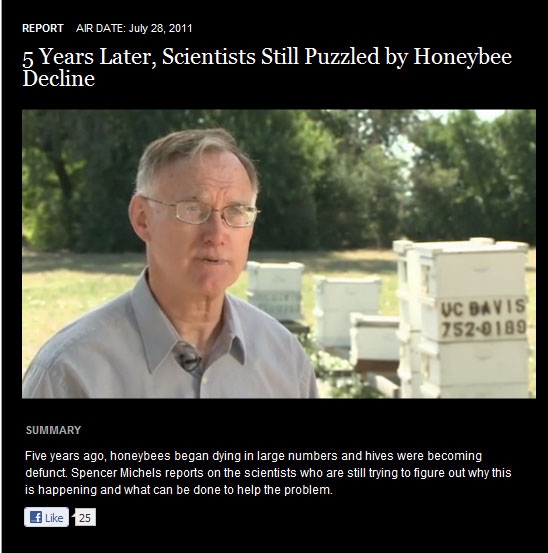
PBS
Eric Mussen on PBS NewsHour tonight
Extension apiculturist Eric Mussen of the UC Davis Department of Entomology will be featured today (Thursday, July 28) on the PBS NewsHour, which is broadcasting a special program on colony collapse disorder (CCD) and the nation’s honey bees.
Correspondent/producer Spencer Michels recently interviewed Mussen at the Harry H. Laidlaw Jr. Honey Bee Research Facility at UC Davis and toured the half-acre Häagen-Dazs Honey Bee Haven.
The same program will air at both 3 and 6 p.m. on the West Coast. The bee piece will air about “30 or 33 minutes into the show,” Michels said.
“This will feature a number of points of view about the seriousness of colony collapse disorder and where beekeeping is headed in the United States,” Mussen said.
Among others on the program will be beekeeper-researcher Randy Oliver of Grass Valley and scientists in the Joseph DeRisi lab at UC San Francisco. In examining viruses and microbes in healthy commercially managed honey bee colonies over a 10-month period, the UCSF scientists recently discovered four new bee viruses, a discovery that may help unlock the secrets of why the bee population is declining. Among the scientists: Michelle Flenniken, a postdoctoral fellow in the Raul Andino lab at UCSF and the recipient of the Häagen-Dazs Postdoctoral Fellowship in Honey Bee Biology at UC Davis. See news story.
Africanized honeybees strike in Modesto
A swarm of Africanized honeybees attacked a 70-year-old man in Modesto last week in the first reported assault by so-called "killer bees" north of Tulare, the Modesto Bee reported. The man was stung more than 50 times, but survived the attack.
Laboratory tests determined the bees were "Africanized," or hybrids descended from swarms moving north from Brazil since scientists brought African bees to breed in the late 1950s.
A UC publication, Africanized Honey Bee Facts, says the insect's killer reputation has been exaggerated. The bees look and pollinate the same as common European honeybees, however, they are less predictable and will pursue a perceived threat for a quarter mile or more.
Victim Jack McBride said the bees zeroed in on his head. They stung inside his nose and on his eyelids, face, neck, armpits and torso, the Bee reported. McBride fell, lost his glasses, tried rolling and finally ran, half-blinded, about one-eighth of a mile to take shelter in a house - bees chasing him the whole way.
Modesto Bee reporter Garth Stapley spoke to UC Cooperative Extension honeybee expert Eric Mussen. He said European honeybees "just don't overdo it like that."
Mussen told the reporter the Africanized honeybees were most likely trucked into the area by a commercial beekeeper to pollinate almonds, and a swarm escaped to establish a new hive. He considers it unlikely that African bees moved that far north on their own without confrontations reported in other counties, such as Fresno and Merced.
The article also ran in the Fresno Bee, the Sacramento Bee and the Boston Herald,
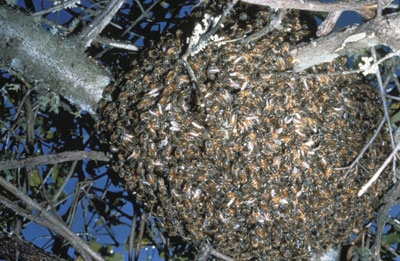
Bees swarm to form new colonies. Swarming bees may rest for a while on a branch or other object, but generally leave in a day or two.
Pollinators are in the news
The insects and animals that bustle from blossom to blossom collecting food while inadvertently pollinating plants are responsible for helping produce some of the healthiest food on the planet. Any threat to pollinators, therefore, is a threat to human health, according to a study published this week in the online journal PLoS ONE.
The study was carried out by an international team that included scientists from UC Berkeley and UC San Francisco. It stemmed from a working group at UC Santa Barbara's National Center for Ecological Analysis and Synthesis, said a UCSB news release.
The research team showed that, globally, "animal-pollinated crops contain the majority of the available dietary lipid, vitamin A, C, and E, and a large portion of the minerals calcium, fluoride, and iron worldwide. The yield increase attributable to animal-dependent pollination of these crops is significant and could have a potentially drastic effect on human nutrition if jeopardized," the release said.
This isn't the only news about the animals that pollinate crops important to the human food supply. In the UC Green Blog yesterday, UC Berkeley writer Ann Guy reported that a UC Berkeley study credited wild bee species with pollinating California crops to the tune of $937 million to $2.4 billion per year. Many of those pollinators are wild bees that live on rangelands – chiefly ranches that graze cattle.
"As it turns out, the farmer and the cowman should be friends," wrote Guy, quoting lyrics from the classic "Oklahoma!" song.
Non-native species, many that serve as hard-working pollinators, were also lauded in a news release distributed this week by writer Kathy Keatley Garvey of the UC Davis Department of Entomology. The release was based on a recent article, published in the journal Nature, titled “Don’t Judge Species on Their Origins." The garden-variety honeybee is a non-native species in the United States.
“Nativeness is not a sign of evolutionary fitness or of a species having positive effects,” the journal article says.
For stunning photos of a variety of pollinators, see Garvey's Bug Squad post on National Pollinator Week.
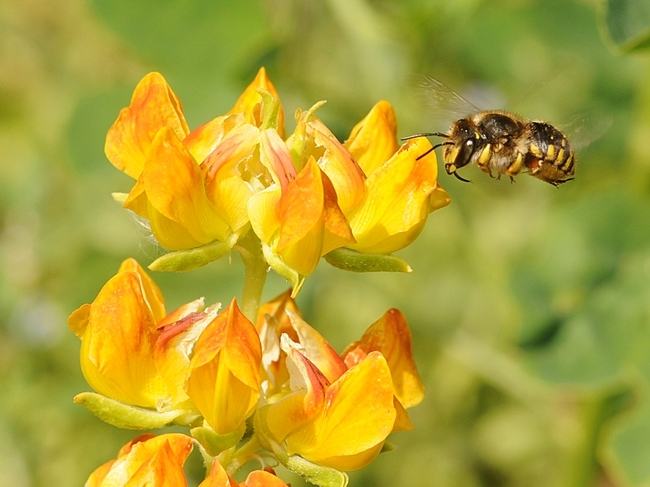
Female wool carder bee (Anthidium manicatum) heads for lupine at the Harry H. Laidlaw Jr. Honey Bee Research Facility, UC Davis. (Photo by Kathy Keatley Garvey)

